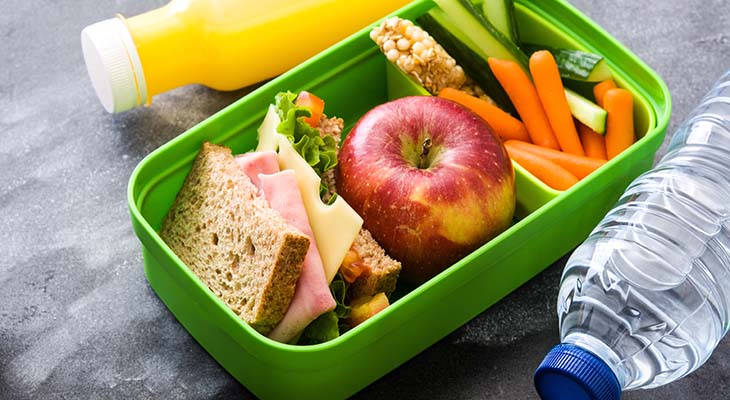
It is somehow that time of the year again. New notebooks, new shoes, new uniforms, new backpacks — but seemingly always the same old lunch day in and day out. This year I promise we are going to change this up and provide our eager learners some fun, nutritious and easy lunches and snacks to bring with them to school. In this post, I’ll explain what should be included in every lunch, easy lunches for parents to make, easy lunches for older students to make for themselves, snack ideas for outside of lunch times, and how to meal-prep effectively and easily leading up to the school week.
When packing lunchboxes, we want to ensure we always have the following components: protein, color, carbs and dairy. Protein is going to be any type of animal products. Examples could be turkey deli meat, hard-boiled eggs, tuna, beef jerky and shredded chicken. We also can find protein in some vegetarian products like dried edamame, tofu, tempeh and quinoa. Protein will help keep us fuller longer as well as aid in recovery from sickness, injury and exercise.
Color is fruits and vegetables. These will provide fiber and a lot of the micronutrients we need, especially when we are growing. Some examples are mixed berries, bananas, apples, clementines, lettuce, tomato, carrots, grapes, watermelon and a mixed salad.
When it comes to carbohydrates, they come in all different shapes and sizes, literally. When we are choosing a carbohydrate for our learner’s lunch, we want to choose nutrient-dense options. This includes, and is not limited to, whole-wheat bread, whole-wheat crackers, pita bread, spinach wraps and pasta.
Dairy is especially important for our growing learners to help with bone growth and health. Some examples of incorporating dairy into lunches are chocolate milk, sliced cheese for a sandwich, cheese sticks, cottage cheese, Greek yogurt and skim/whole milk (depending on the student’s age).
Learn More
If you want to dive deeper into your personal nutrition, set up a free initial consultation by emailing marisa.faibish@nortonhealthcare.org or calling the Norton Sports Health Performance & Wellness Center: (502) 409-8888.
Now that we have a better understanding of what components are necessary in our lunches, here are some examples of easy lunches to make.
Young learners (elementary and below)
- Ham/turkey and cheese sandwich, clementine, chocolate milk
- Turkey and cheese roll-ups, whole-wheat crackers, sliced strawberries
- Chicken-and-cheese quesadilla, sliced apples
- PB&J, Greek yogurt, sliced kiwi
For our older learners, if they are ready to have some of their own responsibilities, the following lunches can be a great start to taking on some ownership of their individual nutrition!
- Turkey, lettuce, tomato, cheese sub with an apple, and Greek yogurt
- Pasta salad with shredded chicken and veggies, mixed berries on the side with a glass of chocolate milk
- Peanut butter and banana sandwich with hard-boiled eggs, carrot sticks and a glass of skim milk
All this talk about lunch almost had me forget the most important meal of the day … breakfast! Fueling our bodies doesn’t start when the bell rings for lunch; it starts before we even get to school with a healthy, balanced breakfast. Much as with lunch, we want to incorporate all of the same components on our plate.
Breakfast is an integral part of the school day because it helps our bodies wake up and get ready for a long day of learning. Imagine going to work on an empty stomach: How much work do you get done before you eat? Probably not a whole lot! A quick and easy breakfast can be an egg-and-cheese sandwich on an English muffin with a bowl of mixed fruit, or a fruit smoothie with Greek yogurt added for protein.
Everyone’s lunchtime can be at different times of the day, some as early as 10 a.m. and some as late as 1 p.m. We may have to go hours without eating a meal while also trying to pay attention in class and retain information. The thought of having to pay attention while hungry sounds daunting and difficult to truly succeed.
Most schools have a break throughout the day, which creates a great opportunity to incorporate a nutritious and filling snack to hold us over until lunchtime or after lunchtime if it is an early one. When it comes to our snacks, we want to incorporate a protein and a carb together. Instead of having just an apple, have an apple with a cheese stick. This will provide us more calories to hold us over. Some other examples are hummus and pretzels, beef jerky and crackers, pretzels and trail mix, Greek yogurt with applesauce, and banana and peanut butter. Note that nut and seed products are primarily a healthy fat source with some protein.
I understand that making snacks and meals each day can be time-consuming and stressful if we are busy running around from one sports practice to another and back to work. Meal-prepping can be a nice way to save us some time throughout the week. We can make shredded chicken pasta salad in bulk on Sunday and distribute evenly into containers labeled with each day of the week. Being able to have a section in our refrigerator designated for lunches and snacks for our learners can help us save a lot of time and energy, not to mention give us a little peace of mind! Sandwiches made a couple days in advance can get soggy. Try prepping sandwiches the night before to free up some of your morning and let you go to bed knowing you are all set for the next day.
If you find grocery shopping stressful and need a little more guidance in that area, here is an excellent guide by a credible source: the Academy of Nutrition and Dietetics’ “Creating a Grocery List.”
Marisa Faibish, M.S., R.D., CSSD, LDN, is lead performance dietitian at Norton Sports Health Performance & Wellness Center.
